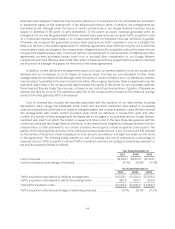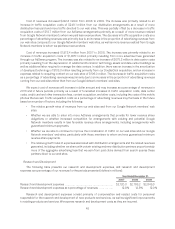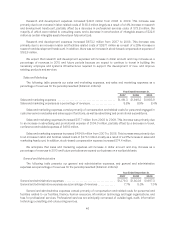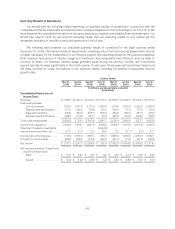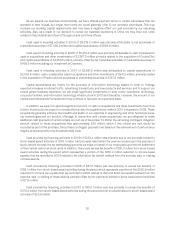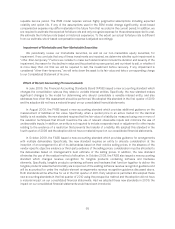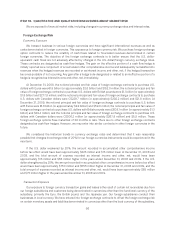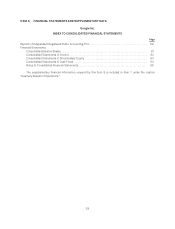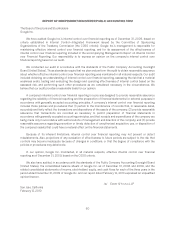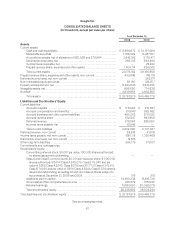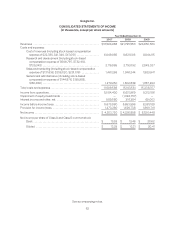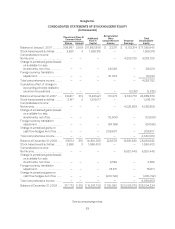Google 2009 Annual Report Download - page 72
Download and view the complete annual report
Please find page 72 of the 2009 Google annual report below. You can navigate through the pages in the report by either clicking on the pages listed below, or by using the keyword search tool below to find specific information within the annual report.At December 31, 2009, our aggregate outstanding non-cancelable guaranteed minimum revenue share
commitments totaled $133.3 million through 2012 compared to $1,030.3 million at December 31, 2008.
Off-Balance Sheet Entities
At December 31, 2009, we did not have any off-balance-sheet arrangements, as defined in Item 303(a)(4)(ii)
of SEC Regulation S-K, that have or are reasonably likely to have a current or future effect on our financial
condition, changes in our financial condition, revenues, or expenses, results of operations, liquidity, capital
expenditures, or capital resources that is material to investors.
Critical Accounting Policies and Estimates
We prepare our Consolidated Financial Statements in accordance with accounting principles generally
accepted in the U.S. In doing so, we have to make estimates and assumptions that affect our reported amounts of
assets, liabilities, revenues, and expenses, as well as related disclosure of contingent assets and liabilities. In some
cases, we could reasonably have used different accounting policies and estimates. In some cases, changes in the
accounting estimates are reasonably likely to occur from period to period. Accordingly, actual results could differ
materially from our estimates. To the extent that there are material differences between these estimates and
actual results, our financial condition or results of operations will be affected. We base our estimates on past
experience and other assumptions that we believe are reasonable under the circumstances, and we evaluate these
estimates on an ongoing basis. We refer to accounting estimates of this type as critical accounting policies and
estimates, which we discuss further below. We have reviewed our critical accounting policies and estimates with
the audit committee of our board of directors.
Income Taxes
We are subject to income taxes in the U.S. and numerous foreign jurisdictions. Significant judgment is
required in evaluating our uncertain tax positions and determining our provision for income taxes.
Although we believe we have adequately reserved for our uncertain tax positions, no assurance can be given
that the final tax outcome of these matters will not be different. We adjust these reserves in light of changing facts
and circumstances, such as the closing of a tax audit or the refinement of an estimate. To the extent that the final
tax outcome of these matters is different than the amounts recorded, such differences will impact the provision for
income taxes in the period in which such determination is made. The provision for income taxes includes the
impact of reserve provisions and changes to reserves that are considered appropriate, as well as the related net
interest.
Our effective tax rates have differed from the statutory rate primarily due to the tax impact of foreign
operations, state taxes, certain benefits realized related to stock option activities, and research and
experimentation tax credits. The effective tax rates were 25.9%, 27.8%, and 22.2% for 2007, 2008, and 2009.
Our future effective tax rates could be adversely affected by earnings being lower than anticipated in countries
where we have lower statutory rates and higher than anticipated in countries where we have higher statutory rates,
the net gains and losses recognized by legal entities on certain hedges and related hedged intercompany and other
transactions under our foreign exchange risk management program, changes in the valuation of our deferred tax
assets or liabilities, or changes in tax laws, regulations, accounting principles, or interpretations thereof. In addition,
we are subject to the continuous examination of our income tax returns by the Internal Revenue Service and other
tax authorities. We regularly assess the likelihood of adverse outcomes resulting from these examinations to
determine the adequacy of our provision for income taxes.
Stock-Based Compensation
Our stock-based compensation expense is estimated at the grant date based on the award’s fair value as
calculated by the Black-Scholes-Merton (BSM) option-pricing model and is recognized as expense over the
54


